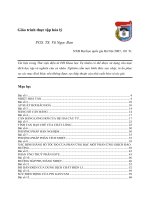Giáo trình bài tập dsp danh sach diem bai tap cac chuong 0 1 2 20072015
Bạn đang xem bản rút gọn của tài liệu. Xem và tải ngay bản đầy đủ của tài liệu tại đây (1.1 MB, 45 trang )
Chapter 1
Sampling and Reconstruction
Nguyen Thanh Tuan, Click
M.Eng.
to edit Master subtitle style
Ho Chi Minh City University of Technology
Email:
Content
Sampling
Sampling theorem
Spectrum of sampling signals
Anti-aliasing pre-filter
Ideal pre-filter
Practical pre-filter
Analog reconstruction
Ideal reconstructor
Practical reconstructor
Digital Signal Processing
2
Sampling and Reconstruction
1. Introduction
A typical signal processing system includes 3 stages:
The analog signal is digitalized by an A/D converter
The digitalized samples are processed by a digital signal processor.
The digital processor can be programmed to perform signal processing
operations such as filtering, spectrum estimation. Digital signal processor can be
a general purpose computer, DSP chip or other digital hardware.
The resulting output samples are converted back into analog by a
D/A converter.
Digital Signal Processing
3
Sampling and Reconstruction
2. Analog to digital conversion
Analog to digital (A/D) conversion is a three-step process.
x(t)
Sampler
t=nT
x(t)
x(nT)≡x(n) Quantizer xQ(n) Coder
A/D converter
x(n)
t
Digital Signal Processing
11010
n
4
111 xQ(n)
110
101
100
011
010
001
000
n
Sampling and Reconstruction
3. Sampling
Sampling is to convert a continuous time signal into a discrete time
signal. The analog signal is periodically measured at every T seconds
?
x(n)≡x(nT)=x(t=nT), n=…-2, -1, 0, 1, 2, 3…
T: sampling interval or sampling period (second);
Fs=1/T: sampling rate or frequency (samples/second or Hz)
Digital Signal Processing
5
Sampling and Reconstruction
Example 1
The analog signal x(t)=2cos(2πt) with t(s) is sampled at the rate Fs=4
Hz. Find the discrete-time signal x(n) ?
Solution:
x(n)≡x(nT)=x(n/Fs)=2cos(2πn/Fs)=2cos(2πn/4)=2cos(πn/2)
n
0
1
2
3
4
x(n)
2
0
-2
0
2
Plot the signal
Digital Signal Processing
6
Sampling and Reconstruction
Example 2
Consider the two analog sinusoidal signals
7
1
x1 (t ) 2cos(2 t ), x2 (t ) 2cos(2 t ); t ( s)
8
8
These signals are sampled at the sampling frequency Fs=1 Hz.
Find the discrete-time signals ?
Solution:
1
71
7
) 2cos(2
n) 2cos( n)
Fs
81
4
1
2cos((2 ) n) 2cos( n)
4
4
1
11
1
x2 (n) x2 (nT ) x2 (n ) 2cos(2
n) 2cos( n)
Fs
81
4
x1 (n) x1 (nT ) x1 (n
Observation: x1(n)=x2(n) based on the discrete-time signals, we
cannot tell which of two signals are sampled ? These signals are
called “alias”
Digital Signal Processing
7
Sampling and Reconstruction
F2=1/8 Hz
F1=7/8 Hz
Fs=1 Hz
Fig: Illustration of aliasing
Digital Signal Processing
8
Sampling and Reconstruction
4. Aliasing of Sinusoids
In general, the sampling of a continuous-time sinusoidal signal
x(t ) A cos(2 F0t ) at a sampling rate Fs=1/T results in a
discrete-time signal x(n).
The sinusoids xk (t ) A cos(2 Fk t ) is sampled at Fs , resulting
in a discrete time signal xk(n).
If Fk=F0+kFs, k=0, ±1, ±2, …., then x(n)=xk(n) .
Proof: (in class)
Remarks: We can that the frequencies Fk=F0+kFs are
indistinguishable from the frequency F0 after sampling and hence
they are aliases of F0
Digital Signal Processing
9
Sampling and Reconstruction
5. Spectrum Replication
Let x(nT ) x (t ) x(t ) (t nT ) x(t )s(t ) where s(t )
n
(t nT )
n
s(t) is periodic, thus, its Fourier series are given by
s (t )
Se
n
n
j 2 Fs nt
where Sn
1
1
1
j 2 Fs nt
(
t
)
e
dt
(
t
)
dt
T T
T T
T
1 j 2 Fsnt
Thus, s(t ) e
T n
1
x (t ) x(t ) s(t ) x(t )e j 2 nf st
which results in
T n
1
Taking the Fourier transform of x (t ) yields X ( F ) X ( F nFs )
T n
Observation: The spectrum of discrete-time signal is a sum of the
original spectrum of analog signal and its periodic replication at the
interval Fs.
Digital Signal Processing
10
Sampling and Reconstruction
Fs/2 ≥ Fmax
Fig: Spectrum replication caused by sampling
Fig: Typical badlimited spectrum
Fs/2 < Fmax
Fig: Aliasing caused by overlapping spectral replicas
Digital Signal Processing
11
Sampling and Reconstruction
6. Sampling Theorem
For accurate representation of a signal x(t) by its time samples x(nT),
two conditions must be met:
1) The signal x(t) must be band-limited, i.e., its frequency spectrum must
be limited to Fmax .
Fig: Typical band-limited spectrum
2) The sampling rate Fs must be chosen at least twice the maximum
Fs 2 Fmax
frequency Fmax.
Fs=2Fmax is called Nyquist rate; Fs/2 is called Nyquist frequency;
[-Fs/2, Fs/2] is Nyquist interval.
Digital Signal Processing
12
Sampling and Reconstruction
The values of Fmax and Fs depend on the application
Application
Fmax
Fs
Biomedical
1 KHz
2 KHz
Speech
4 KHz
8 KHz
Audio
20 KHz
40 KHz
Video
4 MHz
8 MHz
Digital Signal Processing
13
Sampling and Reconstruction
Digital Signal Processing
14
Sampling and Reconstruction
7. Ideal analog reconstruction
Fig: Ideal reconstructor as a lowpass filter
An ideal reconstructor acts as a lowpass filter with cutoff frequency
equal to the Nyquist frequency Fs/2.
T
An ideal reconstructor (lowpass filter) H ( F )
0
Then
Digital Signal Processing
F [ Fs / 2, Fs / 2]
otherwise
X a ( F ) X ( F )H ( F ) X ( F )
15
Sampling and Reconstruction
Example 3
The analog signal x(t)=cos(20πt) is sampled at the sampling
frequency Fs=40 Hz.
a) Plot the spectrum of signal x(t) ?
b) Find the discrete time signal x(n) ?
c) Plot the spectrum of signal x(n) ?
d) The signal x(n) is an input of the ideal reconstructor, find the
reconstructed signal xa(t) ?
Digital Signal Processing
16
Sampling and Reconstruction
Example 4
The analog signal x(t)=cos(100πt) is sampled at the sampling
frequency Fs=40 Hz.
a) Plot the spectrum of signal x(t) ?
b) Find the discrete time signal x(n) ?
c) Plot the spectrum of signal x(n) ?
d) The signal x(n) is an input of the ideal reconstructor, find the
reconstructed signal xa(t) ?
Digital Signal Processing
17
Sampling and Reconstruction
Remarks: xa(t) contains only the frequency components that lie in the
Nyquist interval (NI) [-Fs/2, Fs/2].
sampling at Fs
ideal reconstructor
x(t), F0 NI ------------------> x(n) ----------------------> xa(t), Fa=F0
sampling at Fs
ideal reconstructor
xk(t), Fk=F0+kFs-----------------> x(n) ---------------------> xa(t), Fa=F0
The frequency Fa of reconstructed signal xa(t) is obtained by adding
to or substracting from F0 (Fk) enough multiples of Fs until it lies
within the Nyquist interval [-Fs/2, Fs/2]. That is
Fa F mod( Fs )
Digital Signal Processing
18
Sampling and Reconstruction
Example 5
The analog signal x(t)=10sin(4πt)+6sin(16πt) is sampled at the rate 20
Hz. Find the reconstructed signal xa(t) ?
Digital Signal Processing
19
Sampling and Reconstruction
Example 6
Let x(t) be the sum of sinusoidal signals
x(t)=4+3cos(πt)+2cos(2πt)+cos(3πt) where t is in milliseconds.
a) Determine the minimum sampling rate that will not cause any
aliasing effects ?
b) To observe aliasing effects, suppose this signal is sampled at half its
Nyquist rate. Determine the signal xa(t) that would be aliased with
x(t) ? Plot the spectrum of signal x(n) for this sampling rate?
Digital Signal Processing
20
Sampling and Reconstruction
8. Ideal antialiasing prefilter
The signals in practice may not band-limited, thus they must be
filtered by a lowpass filter
Fig: Ideal antialiasing prefilter
Digital Signal Processing
21
Sampling and Reconstruction
9. Practical antialiasing prefilter
A lowpass filter: [-Fpass, Fpass] is the frequency range of interest for
the application (Fmax=Fpass)
The Nyquist frequency Fs/2 is in the middle of transition region.
The stopband frequency Fstop and the minimum stopband
attenuation Astop dB must be chosen appropriately to minimize the
aliasing effects.
Fs Fpass Fstop
Fig: Practical antialiasing lowpass prefilter
Digital Signal Processing
22
Sampling and Reconstruction
The attenuation of the filter in decibels is defined as
A( F ) 20log10
H (F )
(dB)
H ( F0 )
where f0 is a convenient reference frequency, typically taken to be at
DC for a lowpass filter.
α10 =A(10F)-A(F) (dB/decade): the increase in attenuation when F is
changed by a factor of ten.
α2 =A(2F)-A(F) (dB/octave): the increase in attenuation when F is
changed by a factor of two.
Analog filter with order N, |H(F)|~1/FN for large F, thus α10 =20N
(dB/decade) and α10 =6N (dB/octave)
Digital Signal Processing
23
Sampling and Reconstruction
Example 6
A sound wave has the form
x(t ) 2 A cos(10 t ) 2 B cos(30 t ) 2C cos(50 t )
2 D cos(60 t ) 2 E cos(90 t ) 2 F cos(125 t )
where t is in milliseconds. What is the frequency content of this
signal ? Which parts of it are audible and why ?
This signal is prefilter by an anlog prefilter H(f). Then, the output y(t)
of the prefilter is sampled at a rate of 40KHz and immediately
reconstructed by an ideal analog reconstructor, resulting into the final
analog output ya(t), as shown below:
Digital Signal Processing
24
Sampling and Reconstruction
Example 7
Determine the output signal y(t) and ya(t) in the following cases:
a)When there is no prefilter, that is, H(F)=1 for all F.
b)When H(F) is the ideal prefilter with cutoff Fs/2=20 KHz.
c)When H(F) is a practical prefilter with specifications as shown
below:
The filter’s phase response is assumed to be ignored in this example.
Digital Signal Processing
25
Sampling and Reconstruction









